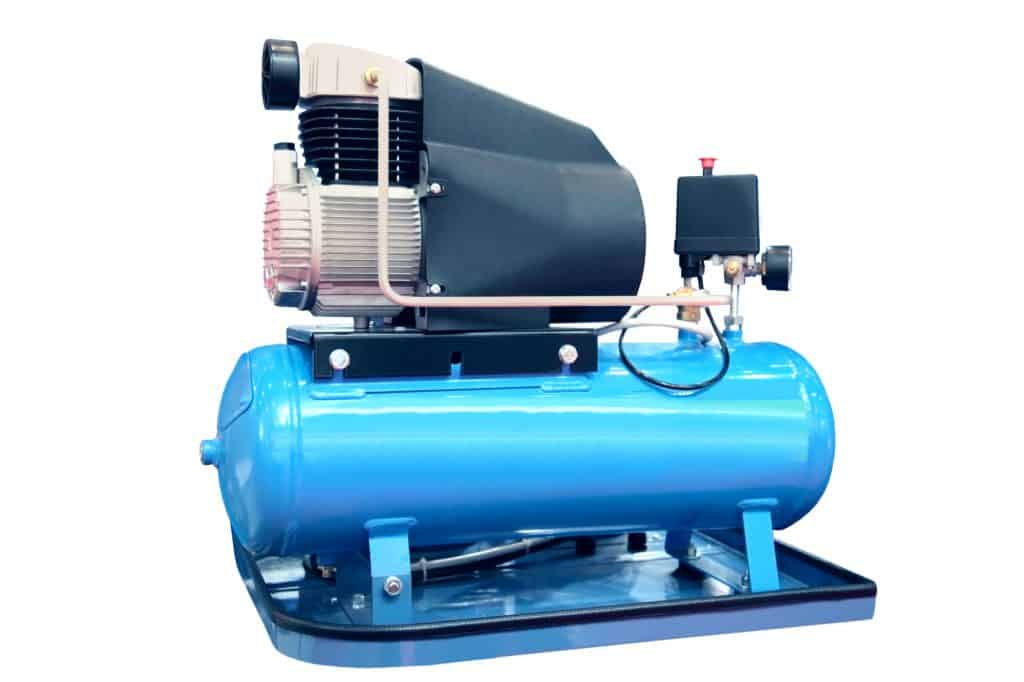Whether you want to keep your compressor in your trunk for tire-related emergencies or use it while you’re on the job, it is crucial to take some steps before hitting the road. Air compressors are easy to travel with, provided that you keep them in good condition.
You can leave an air compressor in a hot car, as long as you prepare your tank for transport. Leaving your tank pressurized, full of condensate, or unsecured could result in dangerous pressure buildup, which could cause an explosion under certain circumstances.
So, let’s get into the details and talk about how to keep your air compressor in good condition while you travel with it. I’ll teach you how to prep your tank for transport and tell you about the conditions that could cause your air compressor to break or fail.
Preparing the Tank for Transport
Before you hit the road with your air compressor, it is best to ensure that you have taken the proper precautions to avoid hazardous situations.
To prepare your tank for transport, you will need to release the pressure, drain the condensate, and secure your tank. Following these steps can prevent damage to your air compressor and ensure that the tank does not explode while in motion.
Now, let’s talk about why these steps are necessary. I’ll guide you through the proper ways to prepare your air compressor tank for transportation so that it stays in good shape, no matter where you go.
Releasing Pressure
Air compressors make pressure – that’s their job. However, this pressure can be dangerous when transporting a tank.
When air compressors create pressure, they create a vacuum inside the tank.
If you puncture the metal casing around your compressor while it is at high pressure, the small hole or crack will shoot out air at an extremely high force, potentially causing an explosion.
During transportation, many things can go wrong with a pressurized air compressor. For example, if you get in an accident or if the tank falls from its place, it could crack, causing a violent outburst of highly pressurized air.
If your idea of a good time doesn’t involve a broken air compressor flying around your car at high speeds, you should always depressurize it before traveling.
To release air pressure from your tank:
- Turn off the air compressor and unplug it from its power source.
- Locate your safety release valve.
- Pull up on the safety release valve, releasing air from the tank.
- Once the PSI gauge reads 10 PSI (68.9 kPa) or below, you can let go of the safety release valve.
It is also essential to depressurize your tank before completing the next step, draining the condensate from your air compressor.

Drain the Condensate
Draining the condensate from your air compressor after using it is a crucial part of tank maintenance.
Condensate is made up of water derived from the air and tiny bits of lubricants from your tank. This liquid becomes concentrated when you use your air compressor. Most tanks have a condensate trap that you can use to drain the fluid.
If you leave the liquid inside your air compressor, you risk dangerous consequences. Most air compressors are made of steel, and steel rusts if you leave condensate sitting on it.
This rust can damage your air compressor beyond repair. Also, according to experts, the leading cause of air compressor explosions is corrosion.
In addition, leaving liquids in your air compressor can break the pipe system inside, especially under freezing conditions. Since water expands when it freezes, leaving fluids inside your air compressor could result in cracked pipes and gaskets.
During transportation, if you leave the moisture in your air compressor, it may leak, or the liquid could move into other tank components. So, it’s always a good idea to drain condensate before storing or transporting your air compressor.
To remove the condensate from your air compressor, you will need to locate the drain valve. On most air compressors, this small valve is located at the bottom of the tank, but some tanks have side drain valves located on the side of the tank.
Here’s how to drain your tank:
- Turn off your air compressor.
- Depressurize your tank.
- Place a pan or bucket underneath the drain valve.
- Slowly unscrew the valve, being careful to take your time to avoid splashing and shooting liquid.
- For air compressors with a bottom valve, tilt the tank to pour the condensate out.
- For air compressors with a side drain valve, turn on the compressor to push the condensate out.
- Once liquid stops pouring out, tighten the drain valve tightly.
Secure the Air Compressor
When traveling, securing your air condenser is crucial if you want to avoid dangerous conditions.
If you don’t secure the air compressor well, it might get jostled around or fall from its position in your car. When this happens, you risk a puncture in your tank, which can cause permanent damage.
If you have already depressurized your tank, then you won’t have to worry about it flying around your car or the freeway, but when you try to use the tank later, the air will leak out, reducing the pressure that your compressor can create.
So, to keep your tank in the best condition possible, secure it well before traveling. You can use any of the following to keep your air compressor where you put it:
- Ropes
- Bungee cords
- Elastic netting
- Blockades
No matter how you secure your air compressor, always ensure that it can’t move around, even if you get in an accident or have to brake quickly.
How Hot Can Air Compressors Get?
Temperature can drastically affect your air compressor’s performance, and if you use it in hot weather, it is at risk of overheating.
Air compressors heat up when you use them since they create friction and pressure. They usually reach temperatures between 185°F and 190°F (85°C and 88°C) while in use. If your air compressor gets any hotter, it will likely automatically shut down.
Air compressors are made to be usable in various weather conditions, but sometimes, the weather is too hot to use them safely.
The maximum temperature that you should use your air compressor at is between 100°F and 104°F (37.7°C and 40°C). That’s because, when the weather is that hot, your air compressor will overheat more quickly, and it won’t be able to cool down on its own.
How To Tell If Your Air Compressor Is Safe To Use
Sometimes, when there is internal damage to your air compressor, it is unsafe to use.
To tell if your air compressor is safe to use, you can take it to a shop that performs hydrostatic tests, which is the best way to check your tank. You can also look for leaks, rust, unsealed valves, or holes in the tank to check for its safety.
Hydrostatic tests measure whether the tank is airtight, and they are the surest way to test your air compressor for safety. However, these tests can be pricey and usually cost around $100, so the test isn’t worth it for cheaper and older air compressors.
There are also some other ways to tell if your air compressor is unsafe:
- Ensure that the safety valve seals and is easy to lift and replace.
- Check for dents, cracks, and holes in the surface of your tank.
- Ensure that the manual drain valve seals properly.
So, if your tank has pinholes or leaks, you should stop using it and replace it with a new air compressor.
Why Can Air Compressors Fail?
There are many reasons why air compressors can fail, but some are more common than others.
The main reason your air compressor may fail is rust and corrosion, which creates holes and rust deposits in the air compressor. Other issues that may cause your tank to fail include pinholes, cracks in piping systems, and blockages.
Rust is common in air compressors. Even with proper care and draining, air compressors may rust over many years, rendering them useless. Rust and sludge buildup can cause blockages in the air tubing in your air compressor, introducing dangerous conditions.
Additionally, holes in the tank can also cause failure, as your tank will no longer be airtight. When that happens, air will release from the compressor, inhibiting the tank from building enough pressure to be efficient.
Cracks inside the tank can also compromise the integrity of your system, allowing air, moisture, and sludge to leak from the tank into the electrical components of your tank.
Conclusion
Leaving your air compressor in a hot car is not a problem as long as you drain the condensate, release the pressure, and secure your tank while transporting it. Heat won’t damage an air compressor as long as you don’t run it in temperatures above 100°F (37.7°C).
However, rust, cracks, broken piping, and blockages in the system can damage your tank, so it’s essential to maintain it properly.
Sources
- HomeSteady: Dangers of an Air Compressor
- Compressor-Pump & Service, Inc.: Keep Your Air Compressor in Great Condition With Proper Storage
- Fluid-Aire Dynamics: Getting Rid of Moisture in Your Compressed Air System
- iPower Toolz: How To Drain Air Compressor
- Air Compressor Planet: Can You Leave an Air Compressor Full?
- VMAC: The Top 10 FAQs About Compressed Air – Fun Facts About Compressed Air
- The Hope Group: Why your air compressor is overheating
- The Garage Journal: When to discard aircompressor tank.

